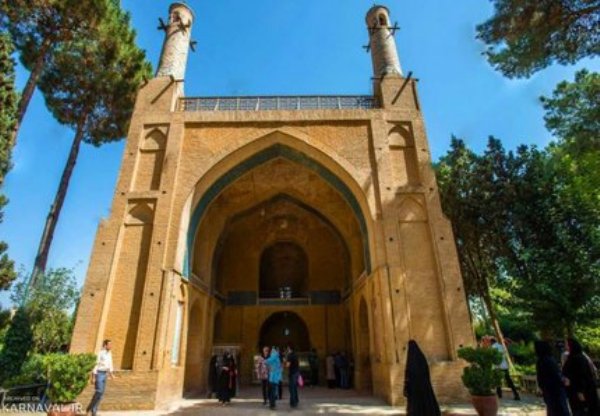
Monar jonban
Minarjonban is one of the historical monuments of Isfahan. This building is actually a mausoleum built on the grave of an ascetic and pious sheikh named "Uncle Abdallah Karladani". In the beginning, it was only a porch, and later two famous Minarets of Minarjonban were added to its building.
Manarjonban used to be located on the road from Isfahan to Najafabad in a village called Karladan, which is now one of the neighborhoods of Isfahan city. The remarkable thing about this historical monument is that by moving one minaret, the other minaret also moves and it is necessary to mention that each minaret is nine meters wide and seventeen meters high. Azure and turquoise tiles decorate this building.
Minarjonban
In Iran, some minarets have the ability to shake, so called minarets. One of the most famous Minarets of Iran is located in Isfahan and the other in Ardakan city and in Kharanaq district of Yazd. The date is written on the stone of Uncle Abdullah.
Location
In the past, Menarjonban was separated from the city and located in a village called "Karladan". But today this place and building is part of Isfahan and is located near a place called Nasrabad (Isfahan). This building is decorated with azure tiles in the shape of a four-pointed star and other shapes in the shape of turquoise polygons.
Features of the building
The fame of Isfahan's Jonban minarets has long been due to the fact that whenever one of the minarets on the sides of the building's porch is moved, this movement is transferred to the other minaret as well. The height of the porch of Uncle Abdullah's tomb is 10 meters from the ground level of the tomb, and the height of each of the two minarets is 7.5 meters. Uncle Abdullah's grave is located in this porch, and the way to climb to the roof and minarets is through a small door that is connected to the roof with a spiral staircase. But what this small building with the width of nine meters and the length of each minaret; What makes seventeen meters famous is its shaking. That is, by shaking one of the minarets, the other minaret and the whole building will also shake. The Manarjanban porch is one of the single-porch works of the Ilkhanate period, which was built in the Mughal style. But the shape of the minarets shows that they were added to the porch at the end of the Safavid period. The reason for the movement of this building has been a question for scientists for a long time and many still say that there is no logical reason for this movement. But the important thing is that Minarjonban is not the only building in the world that moves in this way. Similar buildings can be found in Iraq and Arabia. Anyway, the most logical reason for the shaking of minarets is the physical phenomenon of resonance or resonance effect. Because the minarets are light and quite similar, shaking one affects the other. Tourists who have traveled to different parts of the world have introduced minarets in their observations that have the same characteristics in other parts of the world. But it is certain that Isfahan's Jonban Minar is different from other moving minarets, and that is that apart from the movement of the minarets, other parts of the building also move.
This building is decorated with azure tiles in the shape of a four-pointed star and other shapes in the shape of turquoise polygons. Hamid Shahinpour, head of the research committee of the Iranian Indigenous Technologies Association, decided to find the cause of the vibrations of this building with dynamic formulas. Shahinpour's research with all his complex and laboratory formulas led to the conclusion that: "When we have two similar threads of equal length and tie the ends of these threads to a horizontal thread, two completely similar pendulums are obtained. Now, if one of the threads starts to oscillate, the other one will also start to oscillate. But if one of the threads becomes longer, in case of fluctuation, the other thread will not fluctuate. Now, if the weight of one is different from the other, the fluctuation of one leads to disturbance in the fluctuation of the other. Based on this, we can conclude that the vibration of one minaret can be transferred to the next minaret." Before Shahinpur, other people have worked on Minarjonban, but so far no one had done laboratory work on this building. Shahinpour considers all minarets built in the world to belong to Iranian Islamic culture. It is interesting to know that the minarets of Jinbans in the world were built in a period of thirty years during the Timurid period.




